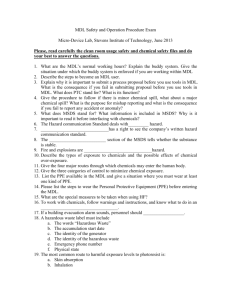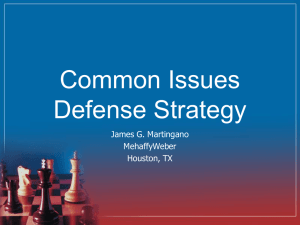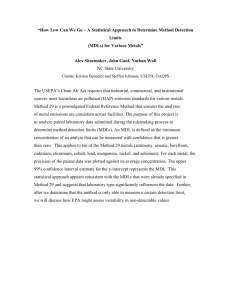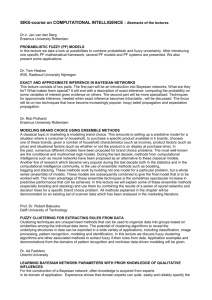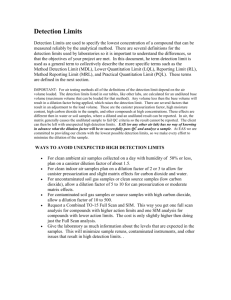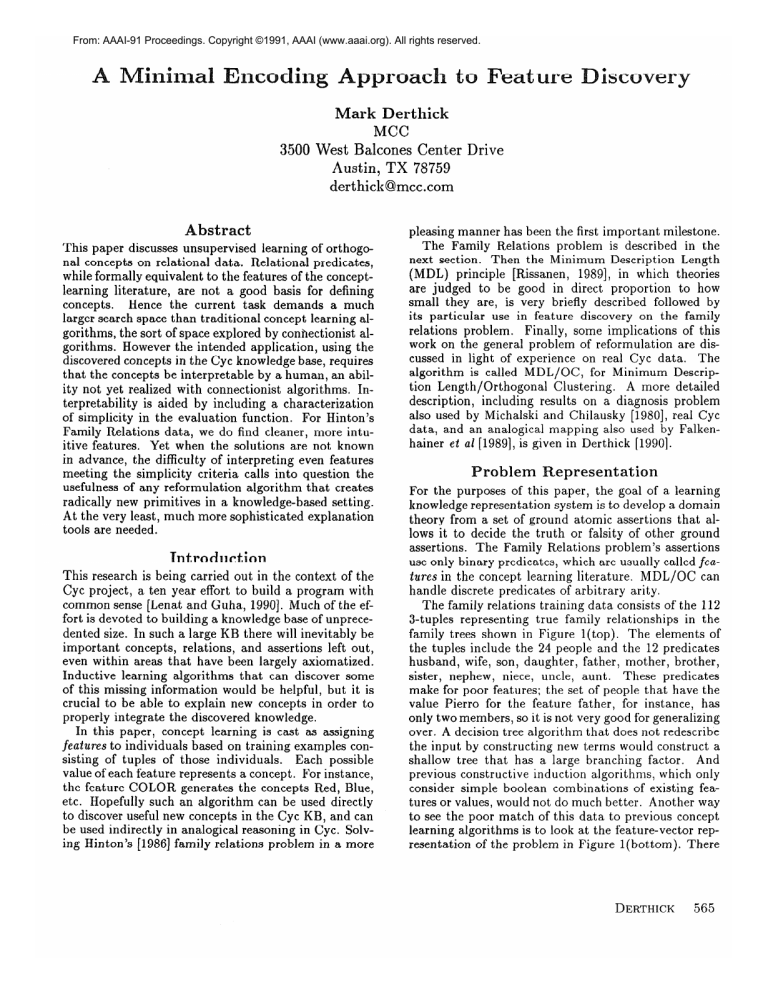
From: AAAI-91 Proceedings. Copyright ©1991, AAAI (www.aaai.org). All rights reserved.
Mark
Derthick
MCC
3500 West Balcones Center Drive
Austin, TX 78759
derthick@mcc.com
Abstract
This paper discusses unsupervised
learning of orthogonal concepts on relational
data. Relational
predicates,
while formally equivalent to the features of the conceptlearning literature,
are not a good basis for defining
concepts.
Hence the current
task demands
a much
larger search space than traditional
concept learning algorithms, the sort of space explored by connectionist
algorithms.
However the intended application,
using the
discovered concepts in the Cyc knowledge base, requires
that the concepts be interpretable
by a human, an ability not yet realized with connectionist
algorithms.
Interpretability
is aided by including
a characterization
of simplicity
in the evaluation
function.
For Hinton’s
Family Relations
data, we do find cleaner, more intuitive features.
Yet when the solutions are not known
in advance, the difficulty of interpreting
even features
meeting the simplicity
criteria calls into question the
usefulness of any reformulation
algorithm
that creates
radically new primitives
in a knowledge-based
setting.
At the very least, much more sophisticated
explanation
tools are needed.
Introduction
This research is being carried out in the context of the
Cyc project, a ten year effort to build a program with
common sense [Lenat and Guha, 19901. Much of the effort is devoted to building a knowledge base of unprecedented size. In such a large KB there will inevitably
be
important
concepts, relations,
and assertions
left out,
even within areas that have been largely axiomatized.
Inductive
learning algorithms
that can discover some
of this missing information
would be helpful, but it is
crucial to be able to explain new concepts in order to
properly integrate the discovered knowledge.
In this paper, concept learning is cast as assigning
features to individuals
based on training examples consisting of tuples of those individuals.
Each possible
value of each feature represents a concept. For instance,
the feature COLOR generates the concepts Red, Blue,
etc. Hopefully such an algorithm
can be used directly
to discover useful new concepts in the Cyc KB, and can
be used indirectly in analogical reasoning in Cyc. Solving Hinton’s [1986] f amily relations problem in a more
pleasing manner has been the first important
milestone.
The Family Relations
problem is described
in the
next section.
Then the Minimum
Description
Length
(MDL) principle
[Rissanen,
19891, in which theories
are judged
to be good in direct proportion
to how
small they are, is very briefly described
followed by
its particular
use in feature discovery on the family
Finally, some implications
of this
relations
problem.
work on the general problem of reformulation
are discussed in light of experience
on real Cyc data.
The
algorithm
is called MDL/OC,
for Minimum
Description Length/Orthogonal
Clustering.
A more detailed
description,
including
results on a diagnosis problem
also used by Michalski and Chilausky
[1980], real Cyc
data, and an analogical mapping also used by Falkenhainer et al [1989], is given in Derthick [1990].
roblem
epresentation
For the purposes of this paper, the goal of a learning
knowledge representation
system is to develop a domain
theory from a set of ground atomic assertions that allows it to decide the truth or falsity of other ground
assertions.
The Family Relations problem’s assertions
use only binary predicates, which are usually called features in the concept learning literature.
MDL/OC
can
handle discrete predicates of arbitrary
arity.
The family relations training data consists of the 112
3-tuples representing
true family relationships
in the
family trees shown in Figure l(top).
The elements of
the tuples include the 24 people and the 12 predicates
husband, wife, son, daughter,
father, mother, brother,
These predicates
sister, nephew, niece, uncle, aunt.
make for poor features; the set of people that have the
value Pierro for the feature father, for instance,
has
only two members, so it is not very good for generalizing
over. A decision tree algorithm that does not redescribe
the input by constructing
new terms would construct a
shallow tree that has a large branching
factor.
And
previous constructive
induction
algorithms,
which only
consider simple boolean combinations
of existing features or values, would not do much better. Another way
to see the poor match of this data to previous concept
learning algorithms is to look at the feature-vector
representation
of the problem in Figure l(bottom).
There
DERTHICK
565
Christopher
7
Penelope Andrew
1’
Margaret
= A!thu;
1
ViAoria
I
p Christine
I
1
r James Jrn&er
Colin
= Charles
C harlotle
Pierro = Francesca
a arco Ange a = ‘lomaso
Gina
AlA
nso
So d hia
(Christopher
Wife Penelope)
(Christopher
Son Arthur)
(Christopher
Daughter Victoria)
Christopher
Charlotte
Arthur
HWSDFMBSNN U
: ----JVC---(CA}{
: -M--CP-VCC
-
: -PAV------
present in a single training example, and testing is accomplished by completing one or a few missing features
values of a new individual.
In MDL/OC,
a training example consists of only a single assertion,
of the form
(PERSON1
GIVEN-PREDICATE
PERSON2).
Testing generalization
on new ground assertions
(termed
“completion”)
is done by a separate system. The intent
is to use the discovered features to help extend a knowledge base with a subtheory of the training domain, and
to have completion
done by the knowledge-based
system. However a simple-minded
algorithm that does not
require a human to integrate the features with existing
concepts in a KB is described in the evaluation
of results section.
Feature Discovery
Coding
A
JM}
-
Figure 1: Top, the family trees from which the 112 training tuples are derived. “2 means “spouse,” and lines mean
“child.” Middle, a few examples of the training tuples for
the family relations problem, in the syntax accepted by
MDL/OC. It is possible to use an feature-value representation of this domain (Bottom), in which the given predicates
Husband, Wife, Son, Daughter, Father, Mother, Brother,
Sister, Nephew, Niece, Uncle, Aunt induce an feature vector on each individual.
Scheme
MDL is a very powerful and general
be applied to any inductive learning
ficient data.
It appeals to Occam’s
566
LEARNING THEORY
AND MDL
razor-the
intuition
that the simplest theory that explains the data is the
best one. The simplicity of the theory is judged by its
length under some encoding scheme chosen subjectively
Its ability to explain the data is
by the experimenter.
measured by the number of bits required to describe
the data given the theory. There is a tradeoff between
having a large theory that requires few additional
data
bits to explain the particular
training set, and having
a small theory that requires much of the information
to be left as data. To ensure that the encoding scheme
is information-preserving,
the task is often thought of
as transmitting
The numare many null values and some multi-values.
ber of values of each feature is large.
Much more desirable would be to construct new predicates that make for more natural features, such as Sex,
Nationality,
or Generation.
These features would still
take a person as an argument,
but their values would
be constructed:
Male, Female, English, Italian,
Old,
Of course the algorithm
cannot
Middle, and Young.
come up with English names for its features and values. But this paper would be even less readable using
gensyms, so it is important
to remember that only the
24 people and 12 given predicates appear in the input,
and that other features and values are names I attached
to partitions
and their elements constructed
by the algorithm.
Somewhat
confusingly,
MDL/OC
does not
distinguish
between predicates
and arguments.
It interprets the training set strictly as a set of tuples, and
discovers new ways to categorize the elements.
To emphasize this, the given predicates and people are sometimes collectively
called individuals.
The feature that
distinguishes
them is useful to the algorithm,
so Type
is another constructed
feature, with values Person and
Given-Predicate.
In algorithms
that represent
an individual
by its
feature-vector,
all assertions
about one individual
are
approach that can
task involving suf-
the training
set to a receiver
using the
fewest bits. There must be an algorithm for the receiver
to reconstruct
the data from the compressed form.
This subsection
assumes that useful features like Sex
have already been found, and the concern is only to
describe how they are used to encode and decode the
training
data, and to measure the resulting
encoding
length.
This length serves as a declarative
evuhalion
The next section defunction over sets of features.
scribes how a weak method is used to search for a set
of features that minimizes the evaluation
function.
MDL/OC’s
encoding scheme reflects two characteristics I believe intuitively
good features should have:
They should enable simple expression
of the domain
constraints, and they should not be redundant.
Redundancy is minimized by any MDL scheme; simplicity
is
enforced by constraining
each feature separately.
For
instance,
the Sex feature of the GIVEN-PREDICATE
element of a tuple perfectly predicts the Sex feature of
the PERSON2 element, independent
of the type, Nationality,
instance,
and branch of the family.
For
Generation,
Mother has the value Female, and any moth-
erhood assertion will
other features listed
ularities.
Once each
ple element has been
feature-values
have a Female PERSON2.
The
have their own independent
regfeature of a missing testing tu-
found, the individuals with these
can be looked up.
MDL/OC
gets its
Data (given)
’ e
Th%%
Christopher
Pierro
ex
(Andrew
son James)
(Andrew
daughter
Jennifer)
(Arthur wife Margaret)
Christopher
Pierro
Male
Male
iati~rm~
y
husband
Christopher
Pierro
Female
English
Is&Geq
ieneration
EE%!
Christopher
Pierro
(Penelope husband
I
I
Male
(Italian)
(Znd-Gen)
Male
English
lst-Gen
lst-Gen
Theory (constructed)
Figure 2: The encoding scheme used by MDL/OC. To transmit the training example (Penelope husband Christopher), the
encoder looks up the feature-vectors for each component of the tuple (columns). Each row then represents a feature-tuple
to be transmitted,
using code-words that have previously been sent to the receiver. The feature value names in this figure
are attached by the experimenter as an aid to understanding. When applied to a given predicate such as husband, the label
“Italian” is in parentheses to indicate that, while husband formally has the Same value for this feature as Emilio, it is not
really meaningful; no pairs of rules differ only in their treatment of the Nationality feature of the GIVEN-PREDICATE
of a
This
tuple. “2nd-Gen” is in parentheses because it really means “same generation” when applied to a GIVEN-PREDICATE.
overloading doesn’t cause problems because the subset of the domain that can appear as a GIVEN-PREDICATE
is disjoint
from that that can appear as a PERSON1 or PERSON2.
power from discovering features that makes this kind
of underlying
regularity apparent.
The convenience afforded by assumptions
of independence
is embraced almost universally
in Rayesian inference.
It is surprising
that there have been few attempts
to discover orthogonal concepts.
One straightforward
encoding scheme would assign
each individual a code-word and transmit
the elements
of each training tuple in order.
However this scheme
ignores the regularities
that hold across each training tuple. Since we are looking for regularities
across
orthogonal
features,
MDL/OC’s
coding scheme (Figure 2) transmits
tuples of feature-values
across individuals (called a feature-iuple)
for each feature, as opposed
to a tuple of feature-values
across features (called a
feaiure-vector)
for each individual.
,At the receiver, the
process is just the reverse. The code-words representing
feature-tuples
are decoded and rearranged
into featurevectors, which are decoded into individuals.
In case
multiple individuals
have the same feature vector, the
message is augmented
with disambiguation
code-words.
For instance, using the features in Figure 2, both Penelope and Christine
have the feature-vector
PFEl,
so
every training tuple in which one of them appears will
require an extra bit.
Using the notation
in figure 3, what ends up being
transmitted
for each training tuple, therefore, is d (=
4 in the figure) feature tuples, rather than n (= 3 for
Family Relations) feature vectors. This is a win if the
codes for feature tuples are shorter than codes for feature vectors by at least n/d, on average.
For Family
Relations,
the average code length for feature vectors
is H(f(7))
= 5.1 bits. Th e average feature tuple code
lengths, H(fi(S)),
are: Type = 0.0, Sex = 1.9, Nationality = 1.0, Generation
= 2.6. So this domain has
regularities allowing feature tuple codes that are indeed
much shorter than feature vector codes.
By Shannon’s
coding theorem,
and assuming
optimal codes, the number of bits required to transmit each
symbol is the negative log of the symbol’s probability
of occurrence.
Summing
this for all the feature-tuple
and disambiguation
codewords gives the total number
of bits for the data term. (Any real code will require an
integral number of bits. However, all the codes in this
and the lengths are calculated
paper are “simulated,”
using information-theoretic
formulas whose range is the
non-negative
real numbers.)
The theory description consists of the number of features (d), individuals (q), training examples (I), training
tuple size (n), number of values for each feature (ci), the
assignment
of individuals
to feature vectors (f), and
the feature-tuple
and disambiguation
codes. There is
insufficient space here to derive the evaluation function
in any detail. In principle, it is just turning the cr&nk.
A code table can be transmitted
as a histogram of symbol frequencies; both transmitter
and receiver can apply
DERTHICK
567
Features
Theory
298
349
(T s N (3
ci =2
s
7
fw
Feature arlties
Random variable ranging over
training tuples. Uniform probabilities.
Random variable ranging over individuals.
Probabilities
match the training data.
Feature vector for individual
7”
ith feature value for individual
7.
ith feature tuple for training example S.
Entropy of a random variable =
the expected number of bits
to encode a value of the variable =
r Pr(.) logPr(.)
Figure 3: Notation used in specifying the MDL/OC eviluation function. Variable values are given for the Family
Relations problem and for the search parameters given in
the search algorithm section.
a previously agreed-on algorithm
to derive an optimal
code from this. Since the total number of symbols (7-d)
and the alphabet size (C cr) are known to the receiver,
straightforward
counting
arguments
lead to a formula
for the number of bits to transmit
the code tables.
In practice, however, this efficient but abstract
approach does not produce a smooth evaluation function.
Although it takes about twice as many bits, the search
works much better with an evaluation function based on
transmitting
the code tables entry by entry. Each entry specifies the code for one symbol. Quinlan (personal
communication)
found the same factor of two worsening
in total number of bits, along with improved search performance, when he used a less abstract coding scheme
in his MDL approach to learning decision trees [Quinlan
and Rivest, 19891. Here this effect is apparently
due to
smoothness,
because the intuitive feature sets are local
optima in both models.
Several approximations
are made to further enhance
the smoothness of the evaluation
function.
The average
number of bits to specify the codes in the code tables
is approximated
by the entropy of the random variable
being coded (or the conditional
entropy of the random
variable given the feature-vector
in the case of the disambiguation
code). This corresponds
to weighting the
average using the observed probabilities
in the data.
The number of bits to transmit
an integer z is approximated log Z. Finally, the log of the arity of a feature
is approximated
by the entropy of its probability
distribution
over all occurrences
of all individuals
in the
training set, logci M H(fi(7)).
When the feature partitions the individuals
so that each value occurs equally
often in the training
set, this approximation
is exact.
As the partition
becomes more uneven, the approxi-
568
LEARNING THEORY
AND MDL
265
215
215
238
199
(T s NtG 3
CT s>
\TTq
‘7
(RANDOM)
(IDENTITY)
197
222
317,808
Feature
Tuples
625
922
296
218
113
296
0
0
335
762
Disambiguation
339
78
899
1066
1179
1036
1402
1711
1375
0
Total
1262
1348
1460
1500
1507
1571
1601
1908
1933
318,570
Table 1: The value of the evaluation function for several
sets of features that I hand-constructed to solve the problem.
The units are bits. T=Type, S=Sex, N=Nationality, and
RANDOM are 2-valued; G=Generation and B=Branch are
3-valued; IDENTITY is 36-valued. When constrained to
find five binary features, MDL/OC achieved a slightly better
score (1260) using a 2-valued version of Generation, and
a feature distinguishing the parents from the non-parents
instead of Branch.
mation varies smoothly
down towards the next lower
arity. I found no smooth approximation
for d, which is
expected to be very small, so it is simply dropped.
The evaluation
function to minimize, including both
theory and data terms, and all the approximations,
is
E(f) = Cyzl [(q+ l)W(fi(T)) + H(fi(S))(enH(fr(T))
+ Z)]
+W + q) . W(I) - WV))) + 1s dn
The constant
terms, H(T) and logqln, can be ignored by the optimization
algorithm.
If there are no
features, f contains no information,
and this reduces to
This is a more precise cal(nl + q) . H(T) + bgqln.
culation for the straightforward
encoding scheme mentioned above in which each tuple element is transmitted
separately.
As f becomes more informative,
H(7) is reduced by H( f (I)), but th e cost of encoding f increases.
In the other limit, where everything
is included in the
theory, there is a single feature with q = 36 values, one
for each individual.
The feature-tuple
code table will
contain qn = 46,656 entries, so this evaluation function, based on transmitting
the table explicitly, blows
up (Table 1).
Search
Algorithm
By virtue of the above declarative specification
of what
constitutes
a good set of features, the learning task has
been cast as a well-defined optimization problem: minimize E(f) over all possible sets of partitions.
Initially
the individuals
are assigned random
values for each fea-
ture. This constitutes
the initial feature-set
hypothesis.
The search procedure thus requires the maximum number of features sought, d,,, , and the maximum number
of values for each, ci,,, , to be fixed in advance.
The search is then carried out by simulated
annealing. This is a generalization
of hill-climbing,
and like
hill-climbing
the search proceeds by evaluating the evaluation function for a configuration
of the search space
that neighbors
the currently
hypothesized
configuration. Depending
on this value, we may “move” to the
neighboring
configuration
as the new hypothesis.
In
MDL/OC, neighboring
feature sets in the search space
are those for which the value of a single feature of a
For instance,
a move might
single individual
differs.
consist of changing the value of Pierro’s Nationality
feature from Italian to English. Since so little is changed
between neighboring
feature sets, it is expected that
the evaluation
function will change smoothly.
This allows the search to descend gradually and hopefully find
the optimal feature set. I have tried more complicated
kinds of moves, but this topology has worked best.
Simulated annealing differs from hill climbing in that
uphill moves are sometimes made, in an effort to avoid
becoming stuck in local optima.
The greater the improvement
in the evaluation
function,
the greater the
chances of accepting a move. The amount of randomness in the decision is controlled by the temperature, T,
which is gradually
decreased during search.
Numerically, Prbo4
= l+e--(c;Reu,-Ihfearrcnl),T *
The parameters
used for the Family Relations problem were as follows: Anneal from an initial temperature
of 500.0 and gradually
decrease until the probability
of
accepting
any move falls below 0.001. This happens
around a temperature
of 1.0 for this problem.
Each
time a move is considered,
the temperature
is multiplied by .999999.
This takes about four hours on a
Symbolics 3630.
Before running any experiments,
I constructed
what
I expected would be the best set of features for this
problem.
Table 1 shows that the evaluation
function
ranks combinations
of these features in a reasonable
way. However MDL/OC
finds slightly different features. This is acceptable
as long as they at least equal
the expected
ones according
to both the evaluation
function and intuition.
Finding five binary features, the
results obtained over 20 trials were as follows: It always
found Type, Sex, and Nationality.
It found ParentalStatus (with two values, Parent and Non-Parent)
19
times, and a skewed version the other time. It found
a a-valued version of Generation
(with values MiddleGeneration
and Old-or-Young-Generation)
13 times,
and a skewed version the other 7 times.
Thus a total of 92 of 100 discovered features were ones to which
intuitive English descriptions
can be attached, and the
remaining
ones were recognizable
variants.
Annealing
ten times as fast, 83% met this criterion; with another
factor of 10 reduction in search time the result was 51%.
Hill climbing gives only 15%. A greedy algorithm that
begins with the identity feature and successively combines the pair of feature values that results in the shortest message length also did very poorly. Noise immunity was quite good, achieving 92% when 10% of the 112
correct patterns
were replaced by tuples in which each
element was randomly selected from the 36 individuals,
and 64% when 25% of the patterns
were replaced.
For these features
the encoding
length
is 1260,
marginally
better than for my solution.
In retrospect,
Parental-Status
is more intuitive
than my attempt
to
define Branch-of-the-Family.
Scaling
There are q individuals
and d features, so the search
- 1)
space size is ndd,l c%. Each point has qCtxl(ci
neighbors.
The time to calculate the change in evaluation function due to a move is proportional
to the number of training examples in which the moving individual
appears.
Assuming individuals
rarely appear multiple
times in a training tuple, this can be approximated
by
d/q.
The number of moves necessary to find a good
solution is difficult to estimate.
The best theoretical
bound that can be proven for simulated
annealing
is
proportional
to the search space size, which is multiply exponential.
In practice, simulated annealing often
works reasonably
fast, so useful scaling estimates
can
only be found empirically.
But it is hard to compare
search time across domains,
because the difficulty of
finding the regularities
in a domain is hard to quantify.
The best approach to equating solution quality seems
to be to adjust the annealing
rate until it is just slow
enough to give a smooth, non-monotonic
energy versus temperature
plot. Using this criterion, the largest
problem I have tried has 30 times more training examples, 200 times more individuals,
and the same values
for d, n, and the cd. It requires between three and four
orders of magnitude
more cpu time. Without more experiments,
all that can be said is that it is worse than
linear and much better than exponential.
One way to
fight this scaling is to shrink the search space by finding only a few features and then “freezing” them while
more are sought.
Evaluation of Results
Just finding features is of no use unless they can be
used to infer new facts, and the ultimate
goal of this
research is to do this by extending
the Cyc knowledge
base with new concepts and rules based on the discovered features.
But even without understanding
the
features and extending
the KB by hand, it is possible to do completion
by considering
the feature-tuple
frequencies as simple kinds of rules. Note that the following procedure is not part of MDL/OC,
but only an
attempt
render its results in a form suitable for quantitative comparison
with other algorithms.
For example, if the assertion (Jennifer brother James) had been
left out of the training set, the completion for (Jennifer
brother ?) could still be found from the five binary
features found by MDL/OC
as follows: The featuretuples that occur in the training data for Sex are FMM,
MMM, MFF, and FFF. Only FMM matches the value
of this feature for the two known elements of the testing tuple, so the missing element must have the value
Male. By similar reasoning,
the missing element must
Nationality=English,
and Generhave Type=Person,
ation=Middle.
For Parental-Status,
Jennifer has the
DERTHICK
569
value NonParent,
and brother has the value Parent, and
both the patterns
NPP and NPN occur in the training
data. However the former occurs 19 times (leaving out
the current assertion)
and the latter only 4. Therefore we guess that the missing element is a Parent.
James is the only individual
with the guessed feature
vector.
However using these five features, even when
the feature-tuple
frequencies
are based on all 112 assertions, completion
percentage
on those same 112 assertions is only 62%. This decreases to 47% when the
frequencies
are based on half the assertions and completion is tested on the other half. In contrast, with a
leave-four-out
testing paradigm,
Hinton achieved 88%
on unseen assertions,
and Quinlan 96%.
Since few algorithms
have been applied to the family
relations data, MDL/OC was also run on the large soybean data in spite of the fact that it is not relational.
Completion
was 69% on the training
set and 74% on
the test set, in contrast
to others who have attained
close to 100% [Michalski and Chilausky,
19801.
Primarily
this poor completion
performance
is because the MDL principle limits discovered knowledge
to that which can be expressed more compactly
than
the data, and MDL/OC ‘s “rule language” is so simple
that only a small class of knowledge can be captured
concisely.
Better completion
was achieved on Family Relations
with an encoding scheme that assumed
the receiver already knew PERSON1 and RELATION,
and so only rewarded features relevant to predicting
PERSON2.
When features with up to five values were
sought, a solution was found that gave 89% and 66%
completion
on the two testing methods.
However the
features were a mess. I believe this indicates that the
encoding scheme described here does a good job of rewarding only simple features,
which are likely to be
most easily interpretable.
It certainly
indicates
that
completion performance
does not always mirror feature
interpretability.
Given that the goal is enhancing
a
knowledge base, rather than doing reasoning directly,
this is an appropriate
tradeoff.
Interpretation
is hard
enough even when learning is very selective.
Indeed, when run on real data from the Cyc KB,
the algorithm found features that were largely uninterpretable.
Having rejected completion
percentage
as a
measure of feature intuitiveness,
and unable to interpret and judge this subjectively,
it is still possible to
evaluate them on the basis of the amount of compression achieved.
For a naive control encoding, I use the
MDL/OC scheme with exactly one feature, which segregates the predicates
from the individuals.
Referring
to Figure 1, the ratio for the Family Relations problem
is 1262/1601=79%.
For one run on Cyc data involving
countries’ trading partners, it is 95%, which considering
how regular the family relations data is, I think significant.
With considerable
effort, involving
automated
search for Cyc predicates correlating
with the features,
I determined
that one of them segregated the countries
according to economy size. I believe this indicates that
even in natural domains, MDL/OC’s
restricted class of
570
LEARNING THEORY
AND MDL
orthogonal
features is useful,
tures are h ard to interpret.
Related
and that
even good fea-
Work
Many hierarchical
clustering
algorithms
have been developed, but as mentioned
in the problem representation section only those that construct
new features are
suited to the Family Relations problem, and none exist
that can form features as far removed from the given
any hierarchiones as is required here. Additionally,
cal algorithm
will suffer data fragmentation.
Near the
leaves they will have so few training instances that observed statistical
regularities
are almost entirely spuPagallo and Haussler [1990] suggest a way to
rious.
recombine identically
structured
subtrees after the tree
is learned. This can be thought of as orthogonalizing.
Because orthogonal
features are not context sensitive,
they should be ideal for analogical reasoning, which after all is just extending
regularities
beyond their customary context. It is appealing that in this sense, doing
completion
with MDL/OC
is doing analogical reasoning without explicitly going through the several stages
customary
in the literature.
Back-propagation
approaches
to feature
discovery
[Hinton, 1986, Miikkulainen
and Dyer, 19871 have suffered from the asymmetric
treatment
of input and output units, and the use of indirect methods like bottlenecks for encouraging
good representations,
rather than
incorporating
an explicit declarative
characterization
of
conciseness.
This is not an inherent limitation;
a backpropagation
version of MDL/OC
is possible.
Declarative evaluation
functions are a more appealing
a priori
way to prevent overfitting
than the post hoc stopping
or pruning criteria using multiple partitions
of the data
into training set, stop training set, and test set. And
these techniques are based on the questionable
assumption that completion
performance
is a good measure of
feature quality.
Information-theoretic
algorithms
[Lucassen,
1983,
Becker and Hinton,
1989, Galland and Hinton, 19901
avoid the asymmetry
of back propagation,
but no other
algorithm
has directly addressed the goals of reducing
redundancy
or generating a simple completion function.
FOIL [Quinlan, 19901 is really not comparable.
Quinlan
used it to learn intensional
definitions of the given predicates in the Family Relations
problem.
This is much
better than the extensional
definitions learned here, but
he did not construct any new predicates.
CIGOL [Muggleton and Buntine, 19881 learns new concepts from relational data, but does not search a large enough space
to construct
the kinds of features that MDL/OC
uses
to constrain the tuple elements.
On the other hand, it
is unnaturally
confining for MDL/OC to rely solely on
constraints,
such as ‘the sex of a female-relation
must
be female.’ Much more informative,
when available, is
data about other relationships
in which the people participate. So an algorithm combining MDL/OC’s ability
to learn radically new concepts with FOIL or CIGOL’s
ability to learn rules involving binary predicates would
be much more powerful than either approach alone.
This paper has described a new approach to unsupervised discovery or orthogonal
features and described
its strengths
and weaknesses.
It is based on a wellmotivated
declarative
description
of what good concepts are. The only subjectivity
that entered in the
derivation
is the decision to use an MDL approach at
all, and the encoding scheme.
The resulting
evaluation function
has no parameters
to adjust.
Actually
finding solutions that optimize the evaluation
function,
however, is an intractable
problem.
The search algorithm used in this paper, simulated
annealing,
does require empirical parameter
setting to work well, and the
search is slow. Although scaling was briefly examined,
more experience
with real-life problems will be necessary to evaluate whether good solutions can be found
in practice.
If orthogonal
features exist for a domain, they are
better than hierarchical
ones, because they allow maximally general inferences.
Algorithms
to find them
should also be more robust, since data fragmentation
is
avoided. It is disappointing
that completion percentage
is not competitive
with other algorithms,
however this
may be a necessary trade-off when seeking simple features. No other algorithm has discovered such clean intuitive features for problems like Family Relations that
are not naturally represented
as feature-vectors.
Therefore I believe the MDL approach, which hopefully can
be extended to more expressive and sophisticated
encoding schemes, is a promising
way to deal with the
interpretation
problem for learning new representation
primitives in a knowledge-based
setting.
Still, the difficulty
of interpreting
feature vectors
learned from real data is surprising and frustrating.
Although this problem has been recognized
and mostly
just accepted as inevitable
for connectionist
learning
systems, there was certainly reason to hope that an algorithm designed to find interpretable
features, would.
Blame on MDL/OC
is misplaced,
I believe.
Rather,
new kinds of interpretation
tools will be required, either acting in concert with a learning algorithm, or post
hoc. Searching for correlations
between the discovered
concepts and existing ones has been of some help in
interpreting
features learned from real Cyc data. This
problem will doubtless
come up for other systems as
they evolve beyond local modifications
to existing representations.
Acknowledgments
I am indebted
to Geoff Hinton
for advice and encouragement
through several active
stages of my obsession with the family relations problem, and to Wei-Min Shen for help during this last
stage reported
here.
I am also grateful for tutoring
in machine learning and suggestions
about MDL/OC
and the presentation
of this paper to Andy Baker, Sue
Becker, Guha, Eric Hartman,
Jim Keeler, Doug Lenat,
Ken Murray,
Jeff Rickel, and an anonymous
reviewer.
eferences
[l] Suzanna
Becker and Geoffrey E. Hinton.
Spatial
coherence as an internal
teacher for a neural network. Technical
Report CRG-TR-89-7,
University
of Toronto, December 1989.
[2] Mark Derthick.
The minimum
description
length
principle applied to feature learning and analogical
mapping.
Technical Report ACT-AI-234-90,
MCC,
June 1990.
[3] Brian Falkenhainer,
Kenneth D. Forbus, and Dedre
Gentner. The structure-mapping
engine: Algorithms
and examples.
Artificial Intelligence,
41:1-63, 1989.
[4] Conrad C. Galland and Geoffrey E. Hinton. Experiments on discovering high order features with mean
field modules. Technical Report CRG-TR-90-3,
University of Toronto, February 1990.
[5] Geoffrey E. Hinton.
tations of concepts.
Learning distributed
represenIn Proceedings of the Eighth
Annual Cognitive Science
Conference,
pages 1-12,
Amherst, Massachusetts,
1986. Cognitive Science Society.
[6] Douglas B. Lenat and R. V. Guha. Building Large
Knowledge-Based
Systems.
Addison-Wesley,
Reading, MA, 1990.
Discovering
phonemic
base
[7] John M. Lucassen.
forms automatically:
An information
theoretic approach. Technical Report RC 9833, IBM, February
1983.
[8] Ryszard S. Michalski and R. L. Chilausky.
Learning
by being told and learning from examples: An experimental comparison
of the two methods of knowledge
acquisition
in the context of developing
an expert
International
system for soybean disease diagnosis.
Journal
of Policy Analysis
and Information
Systems,
1980.
[9] Risto Miikkulainen
and Michael Dyer.
Building
distributed
representations
without
microfeatures.
Technical Report UCLA-AI-87-17,
UCLA, 1987.
[lo] Stephen Muggleton
and Wray Buntine.
Machine
invention of first-order
predicates by inverting resolution. In EWSL-88, pages 339-352, Tokyo, 1988.
Boolean fea[ll] Guilia P a g a 11o and David Haussler.
Machine Learnture discovery in empirical learning.
ing, 5( 1):71-99, 1990.
[12] J. Ross Quinlan and Ronald L. Rivest. Inferring
decision trees using the Minimum Description
Length
Information
and Computation,
80:227principle.
248, 1989.
[13] J. Ross Quinlan.
Learning logical definitions from
relations.
Machine Learning, 5(3), 1990.
[I4] Jorma Rissanen.
Stochastic Complexity in Statistical Inquiry. World Scientific Publishing
Company,
Singapore,
1989.
4(2),
DERTHICK
571


